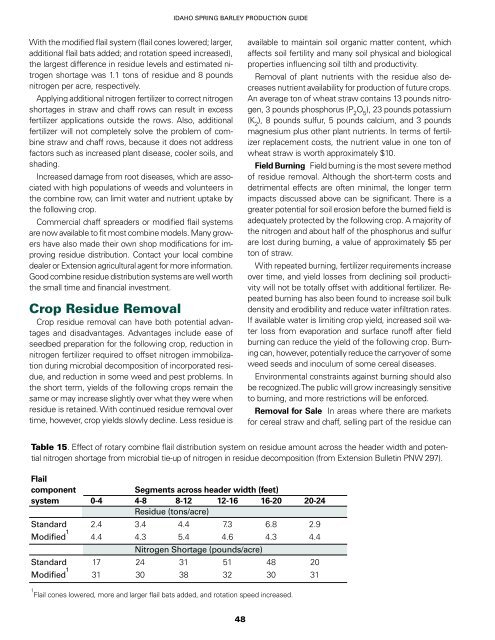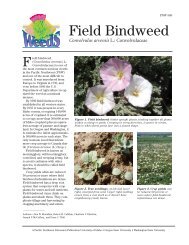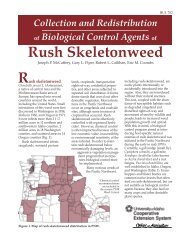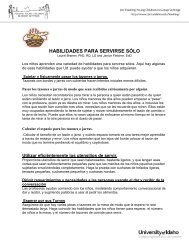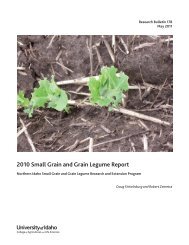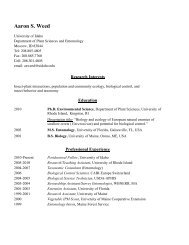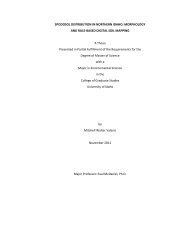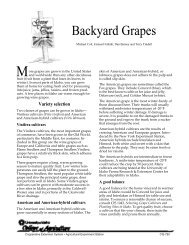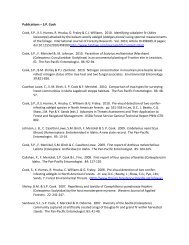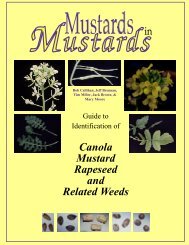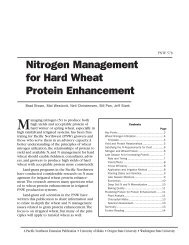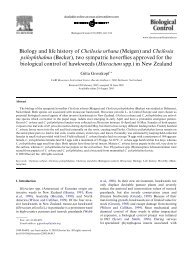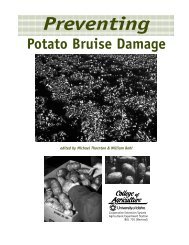Spring Barley Production Guide - College of Agricultural and Life ...
Spring Barley Production Guide - College of Agricultural and Life ...
Spring Barley Production Guide - College of Agricultural and Life ...
You also want an ePaper? Increase the reach of your titles
YUMPU automatically turns print PDFs into web optimized ePapers that Google loves.
With the modified flail system (flail cones lowered; larger,<br />
additional flail bats added; <strong>and</strong> rotation speed increased),<br />
the largest difference in residue levels <strong>and</strong> estimated nitrogen<br />
shortage was 1.1 tons <strong>of</strong> residue <strong>and</strong> 8 pounds<br />
nitrogen per acre, respectively.<br />
Applying additional nitrogen fertilizer to correct nitrogen<br />
shortages in straw <strong>and</strong> chaff rows can result in excess<br />
fertilizer applications outside the rows. Also, additional<br />
fertilizer will not completely solve the problem <strong>of</strong> combine<br />
straw <strong>and</strong> chaff rows, because it does not address<br />
factors such as increased plant disease, cooler soils, <strong>and</strong><br />
shading.<br />
Increased damage from root diseases, which are associated<br />
with high populations <strong>of</strong> weeds <strong>and</strong> volunteers in<br />
the combine row, can limit water <strong>and</strong> nutrient uptake by<br />
the following crop.<br />
Commercial chaff spreaders or modified flail systems<br />
are now available to fit most combine models. Many growers<br />
have also made their own shop modifications for improving<br />
residue distribution. Contact your local combine<br />
dealer or Extension agricultural agent for more information.<br />
Good combine residue distribution systems are well worth<br />
the small time <strong>and</strong> financial investment.<br />
Crop Residue Removal<br />
Crop residue removal can have both potential advantages<br />
<strong>and</strong> disadvantages. Advantages include ease <strong>of</strong><br />
seedbed preparation for the following crop, reduction in<br />
nitrogen fertilizer required to <strong>of</strong>fset nitrogen immobilization<br />
during microbial decomposition <strong>of</strong> incorporated residue,<br />
<strong>and</strong> reduction in some weed <strong>and</strong> pest problems. In<br />
the short term, yields <strong>of</strong> the following crops remain the<br />
same or may increase slightly over what they were when<br />
residue is retained. With continued residue removal over<br />
time, however, crop yields slowly decline. Less residue is<br />
IDAHO SPRING BARLEY PRODUCTION GUIDE<br />
48<br />
available to maintain soil organic matter content, which<br />
affects soil fertility <strong>and</strong> many soil physical <strong>and</strong> biological<br />
properties influencing soil tilth <strong>and</strong> productivity.<br />
Removal <strong>of</strong> plant nutrients with the residue also decreases<br />
nutrient availability for production <strong>of</strong> future crops.<br />
An average ton <strong>of</strong> wheat straw contains 13 pounds nitrogen,<br />
3 pounds phosphorus (P2O5 ), 23 pounds potassium<br />
(K2 ), 8 pounds sulfur, 5 pounds calcium, <strong>and</strong> 3 pounds<br />
magnesium plus other plant nutrients. In terms <strong>of</strong> fertilizer<br />
replacement costs, the nutrient value in one ton <strong>of</strong><br />
wheat straw is worth approximately $10.<br />
Field Burning Field burning is the most severe method<br />
<strong>of</strong> residue removal. Although the short-term costs <strong>and</strong><br />
detrimental effects are <strong>of</strong>ten minimal, the longer term<br />
impacts discussed above can be significant. There is a<br />
greater potential for soil erosion before the burned field is<br />
adequately protected by the following crop. A majority <strong>of</strong><br />
the nitrogen <strong>and</strong> about half <strong>of</strong> the phosphorus <strong>and</strong> sulfur<br />
are lost during burning, a value <strong>of</strong> approximately $5 per<br />
ton <strong>of</strong> straw.<br />
With repeated burning, fertilizer requirements increase<br />
over time, <strong>and</strong> yield losses from declining soil productivity<br />
will not be totally <strong>of</strong>fset with additional fertilizer. Repeated<br />
burning has also been found to increase soil bulk<br />
density <strong>and</strong> erodibility <strong>and</strong> reduce water infiltration rates.<br />
If available water is limiting crop yield, increased soil water<br />
loss from evaporation <strong>and</strong> surface run<strong>of</strong>f after field<br />
burning can reduce the yield <strong>of</strong> the following crop. Burning<br />
can, however, potentially reduce the carryover <strong>of</strong> some<br />
weed seeds <strong>and</strong> inoculum <strong>of</strong> some cereal diseases.<br />
Environmental constraints against burning should also<br />
be recognized. The public will grow increasingly sensitive<br />
to burning, <strong>and</strong> more restrictions will be enforced.<br />
Removal for Sale In areas where there are markets<br />
for cereal straw <strong>and</strong> chaff, selling part <strong>of</strong> the residue can<br />
Table 15. Effect <strong>of</strong> rotary combine flail distribution system on residue amount across the header width <strong>and</strong> potential<br />
nitrogen shortage from microbial tie-up <strong>of</strong> nitrogen in residue decomposition (from Extension Bulletin PNW 297).<br />
Flail<br />
component Segments across header width (feet)<br />
system 0-4 4-8 8-12 12-16 16-20 20-24<br />
Residue (tons/acre)<br />
St<strong>and</strong>ard 2.4 3.4 4.4 7.3 6.8 2.9<br />
Modified 1<br />
4.4 4.3 5.4 4.6 4.3 4.4<br />
Nitrogen Shortage (pounds/acre)<br />
St<strong>and</strong>ard 17 24 31 51 48 20<br />
Modified 1<br />
31 30 38 32 30 31<br />
1<br />
Flail cones lowered, more <strong>and</strong> larger flail bats added, <strong>and</strong> rotation speed increased.


